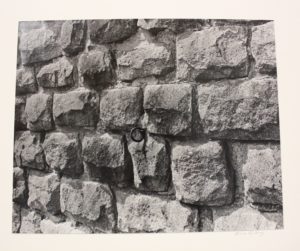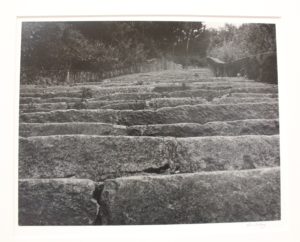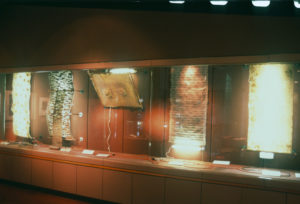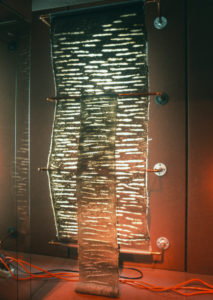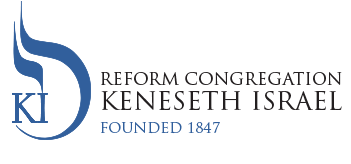- April 9- June 25, 2000
FROM DARKNESS INTO LIGHT: MAUTHAUSEN AND BEYOND
DESCRIPTION: This exhibition focused on a major theme in Jewish life, the remembrance and commemoration of the Holocaust. From Darkness into Light: Mauthausen and Beyond, presented the work of two internationally renowned artists who speak of the Holocaust in quite different visual languages.
The two artists were photographer, Alvin Gilens, and papermaker/sculptor, Robbin Ami Silverberg. Each had visited the site of the Mauthausen Labor Camp near Vienna, Austria, and each had come away with a different way to tell the story of this awful place. Neither artist took a realistic narrative approach to the subject. The horror is too great. Instead, through photographs, book and paper installations, and even neon, the two found idiosyncratic ways to respond to the fact of Mauthausen and other Holocaust sites.
Silverberg’s major work on this theme was fully installed at the Temple Judea Museum. This exhibition was the first presentation of this work as a fully realized installation.
MAUTHAUSEN (BACKGROUND)
The Mauthausen concentration camp near Linz, Austria, specialized in working prisoners to death in its rock quarry. Of the 200,000 men, women, and children who passed through its gates, about 120,000 perished from neglect, overwork and sadistic torture – the highest percentage of all camps within the Reich.
The camp was designed according to the “Dachau model” and followed the established method of mistreating prisoners. But in addition to murder through starvation and beatings, Mauthausen also featured a unique brand of torture devised by camp commander Franz “Babyface” Zeireis. Prisoners were forced to run up 186 steps from the camp’s granite quarry, carrying stones weighing over 100 pounds. If dropped, they crushed the feet of those behind. Every Jew who dropped his load was mercilessly beaten, and the stones were again lifted to his shoulders. In despair, many committed suicide by leaping into the quarry from the cliff above. Some were thrown over the edge by guards, who referred to their victims as “parachute troops”.
Prisoners were also murdered by being forced to run into electrified fences, through shootings in the back of the neck, and with chemical injections directly into the heart.
PHOTOGRAPHS BY ALVIN GILENS
“In the gas chamber was what looked like a showerhead above the middle of the moderate-size concrete wall, but no water came from its openings. As I stepped into the room to document its interior the door closed behind me. A moment of uncontrolled terror passed before I became conscious of the camera in my hand, a reality of time, place, life.”
Robbin Ami Silverberg: BOOK AND PAPER INSTALLATIONS
ARTISTS STATEMENT
“Books are, to me, activated objects. They are culturally charged. They allow me to work with time, in a rhythmic sequence. They can be held and touched. (They allow for) a physical relationship that is missing in almost every other art form. And books necessitate engagement also in their making: I create my own material, so the content starts at the very beginning. The richest experience for me is when all aspects are engaged into the bookmaking: paper, binding, structure, images.
Collaboration is an important part of my work. I found respect early on for the possibility of losing control and, in exchange, gaining access to another person’s creative process.
I do not want to be limited solely to the craft. Technique is for me what helps push artistic ideas. It has to be good so that it does not get in the way of seeing. The magnificent potential of paper offers extraordinary possibilities of expressiveness. But the artist should be able to place the material in its proper context, not under- or overestimating it.”
